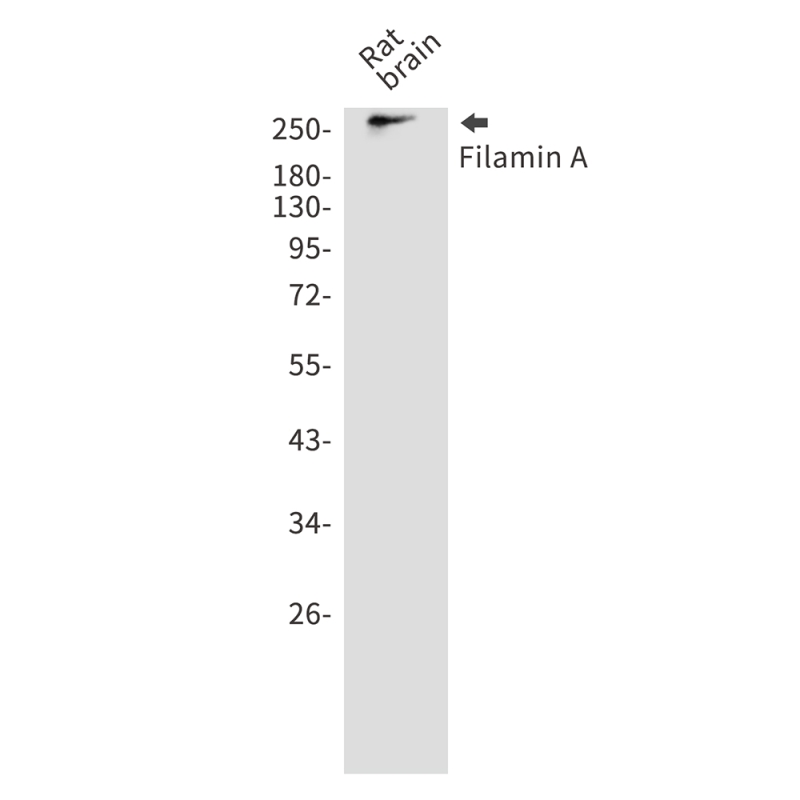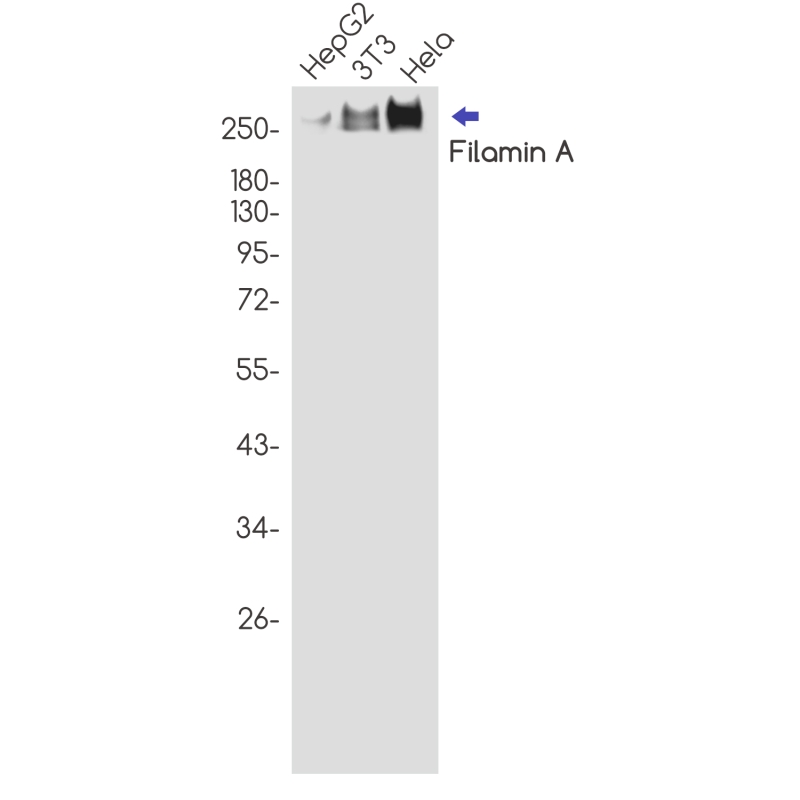

| WB | 1/500-1/1000 | Human,Mouse,Rat |
| IF | 咨询技术 | Human,Mouse,Rat |
| IHC | 1/50-1/100 | Human,Mouse,Rat |
| ICC | 1/50-1/200 | Human,Mouse,Rat |
| FCM | 1/50-1/100 | Human,Mouse,Rat |
| Elisa | 咨询技术 | Human,Mouse,Rat |
| Aliases | ABP-280; ABPX; actin binding protein 280; Alpha-filamin; filamin 1; filamin A; alpha; FLN1; FLNA; FMD; MNS; NHBP; Non-muscle filamin; OPD; OPD1 |
| Entrez GeneID | 2316 |
| WB Predicted band size | Calculated MW: 281 kDa; Observed MW: 281 kDa |
| Host/Isotype | Rabbit IgG |
| Antibody Type | Primary antibody |
| Storage | Store at 4°C short term. Aliquot and store at -20°C long term. Avoid freeze/thaw cycles. |
| Species Reactivity | Human,Mouse,Rat |
| Immunogen | A synthetic peptide of human Filamin A |
| Formulation | Purified antibody in TBS with 0.05% sodium azide,0.05%BSA and 50% glycerol. |
+ +
以下是关于Filamin A抗体的3篇参考文献及其摘要概述:
1. **"Filamins in cell signaling, transcription and organ development"**
*作者:Nakamura F, Stossel TP, Hartwig JH*
摘要:本文综述了Filamin A(FLNA)的结构与功能,重点讨论了其作为细胞骨架交联蛋白的作用,以及通过与其他信号分子(如整合素、Rho GTPases)相互作用调节细胞迁移和信号传导的机制。文中还提及FLNA抗体在定位和功能研究中的应用。
2. **"Mutations in the X-linked filamin A gene cause periventricular nodular heterotopia"**
*作者:Fox JW, Walsh CA*
摘要:该研究通过基因测序和免疫荧光分析,发现FLNA基因突变导致X连锁的脑室周围结节性灰质异位症(PVNH)。作者利用Filamin A抗体在患者细胞中验证了突变蛋白的异常定位,表明FLNA缺失破坏神经元迁移。
3. **"Filamin A regulates cancer cell metastasis through oncogenic signaling and actin cytoskeleton remodeling"**
*作者:Bedolla RG, Wang J, Asuncion A, et al.*
摘要:研究揭示了Filamin A在前列腺癌转移中的作用,通过Western blot和免疫组化(使用Filamin A抗体)发现其表达水平与侵袭性相关,并证明FLNA通过调控Akt/ERK通路促进肿瘤细胞迁移。
4. **"Structural insights into filamin A dynamics and functions"**
*作者:Lad Y, McHugh BJ, Humphries JD, et al.*
摘要:通过冷冻电镜和抗体标记技术,解析了Filamin A的柔性铰链区结构,阐明其如何通过构象变化调节与整合素、细胞膜受体的结合,进而影响细胞力学响应。
这些文献涵盖了Filamin A的结构、疾病关联及抗体在机制研究中的应用。
Filamin A (FLNA) is a cytoskeletal protein that plays a critical role in maintaining cell structure, facilitating signal transduction, and regulating cellular motility. As an actin-binding protein, it crosslinks actin filaments into dynamic networks, contributing to cell shape, adhesion, and migration. FLNA also interacts with numerous signaling molecules, integrins, and membrane receptors, influencing pathways like mTOR and Rho GTPase. Mutations in the FLNA gene are linked to various disorders, including periventricular nodular heterotopia (a brain malformation), skeletal dysplasia, and cardiovascular abnormalities.
Filamin A antibodies are essential tools for studying FLNA's expression, localization, and function in both normal and pathological contexts. These antibodies are widely used in techniques such as Western blotting, immunohistochemistry, and immunofluorescence to detect FLNA in tissues or cultured cells. Their applications extend to cancer research, as FLNA dysregulation is associated with tumor metastasis, and to cardiovascular studies, where FLNA defects impair vascular integrity.
Commercially available Filamin A antibodies vary in clonality (monoclonal/polyclonal), species reactivity, and epitope specificity. Validation often involves knockout cell lines or tissues to confirm target specificity. Researchers must select antibodies based on experimental needs, considering factors like post-translational modifications (e.g., phosphorylation) or disease-specific FLNA isoforms. As FLNA gains attention in mechanobiology and therapeutic targeting, reliable antibodies remain crucial for unraveling its multifaceted roles in health and disease.
×